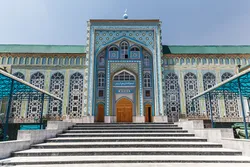See all articles relating to: Tajikistan

Tajikistan, a country in Central Asia. From the Achaemenid Empire to the rule of Alexander the Great, and later the Samanid Empire, this diverse region has been influenced by various cultures throughout its past. Among its important historical figures is Ismail Samani, who led the Samanid Empire to its zenith in the 10th century, promoting Persian language and culture. Another significant figure is Nusratullo Makhsum, a leader of the Basmachi resistance against the Soviet regime in the early 20th century, symbolizing Tajik national pride and resilience. Finally, Emomali Rahmon, who has been Tajikistan's president since 1992, has played a crucial role in the country's post-Soviet development and continues to shape its future.
Research your ancestors on MyHeritage
The administrative divisions of Tajikistan
Tajikistan is divided into several administrative divisions, the country is divided into four provinces and one autonomous province:
- Sughd Province
- Khatlon Province
- Dushanbe (a city with province-level status)
- Region of Republican Subordination (RRS, also known as Directly Ruled Regions)
- Gorno-Badakhshan Autonomous Province
Tajikistan history
See: Tajikistan history
Tajikistan geography
See:
Researching family history in Tajikistan
See also:
- Tajikistan genealogy
- Tajikistan immigration
- Tajikistan emigration
- Tajikistan archives
- Vital records in Tajikistan
- Birth records in Tajikistan
- Death records in Tajikistan
- Marriage records in Tajikistan
- Census records in Tajikistan
- Civil registrations in Tajikistan
- Church records in Tajikistan
- Newspaper records in Tajikistan
- Military records in Tajikistan
Tajikistan ethnicity

Tajikistan is a culturally diverse country, home to a variety of ethnic groups that contribute to its rich cultural tapestry. The majority of the population is comprised of ethnic Tajiks, who speak Tajik, a variant of the Persian language. However, the country also hosts significant minority communities, such as Uzbeks, who form the largest minority and are primarily concentrated in the northern and western regions, as well as smaller groups of Kyrgyz, Russians, and Pamiris. These ethnic groups each bring their own unique customs, languages, and traditions, creating a mosaic of cultural heritage in Tajikistan that fosters a distinctive and dynamic national identity.
See also:
Tajikistan surnames

Understanding the intricacies of Tajik surnames can provide valuable insights when researching family history in Tajikistan. Surnames in Tajikistan typically follow a patronymic system, where a person's last name is derived from their father's first name, with the suffix "-zoda" added for men and "-zodagi" for women. For instance, "Ali-zoda" means "son of Ali" and "Naim-zodagi" means "daughter of Naim". Tajik surnames often hold valuable clues about an individual's familial ties, geographical origins, and ethnic background, providing deeper insights into the family's history and connections within the diverse tapestry of Tajik society.
Examples of different Tajik surnames:
See also:


